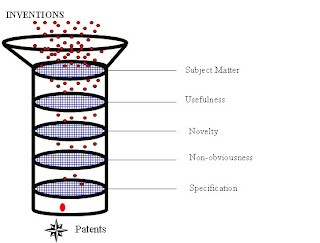First Publication Date: 8th December 2009.
An invention will be eligible to get a patent only if it satisfies the patentability requirements, which are patentable subject matter, industrial applicability/utility, novelty, non-obviousness/inventive step and specification. The government uses the patentability requirements to verify the worthiness of an invention for patent grant. The patentability requirements are like filters arranged in succession as shown in the figure below.
Figure – Kalyan’s Patent Filter Model
A patent will be granted over an invention only if it passes through all the filters. Grant of a patent is the cumulative effect of satisfaction of all the requirements. Analysis of patentability is done step-by-step or filter-by-filter.
The scope of each of the requirements defines the kind of inventions that are eligible to get a patent. In other words, each requirement defines the inventions eligible to enter the patent domain and inventions that fall into the public domain.
Though most countries follow certain basic standards for assessing patentability of an invention, the scope of each of the requirements vary from country to country based on social, economic and ideological factors. Difference in the scope of patentability requirements varies the size of patent and public domain in a country.
Basic Standards Under Trips Agreement
The Agreement on TRIPS is a part of the Marrakesh Agreement signed by various nations establishing the World Trade Organization. This agreement aims at bringing about uniformity and harmonizing intellectual property laws. The agreement aims at providing adequate standards and principles concerning the availability, scope and use of trade-related intellectual property rights.
The TRIPs Agreement provides for four patentability requirements to be satisfied by an invention in order to be eligible for a patent grant . They are subject matter including product or process, novelty, inventive step and industrial application . The agreement obligates member states to treat all fields of technology equally for grant of patents . However, the agreement allows member countries to exclude certain inventions from scope of patentability for protecting public order or morality or animal or plant life or health or environment . It also allows members to exclude certain inventions such as medical methods, plants or animals and so on.
Member countries have the latitude to configure their patentability filters after fulfilling the basic requirements provided in the TRIPs Agreement. The latitude available to the countries over and above the TRIPs standards allows them to define differential requirements, which determines the size of patent and public domain in a country.
In the following posts we will discuss the relationship between the scope of patentability requirements and the patent/public domain balance.
Note: You may use the content for educational purposes only. Appropriate attribution must be for any use. Portions of the content have been published by the author through Manupatra Publications, which owns the copyright over such portions.

A patent will be granted over an invention only if it passes through all the filters. Grant of a patent is the cumulative effect of satisfaction of all the requirements. Analysis of patentability is done step-by-step or filter-by-filter.
The scope of each of the requirements defines the kind of inventions that are eligible to get a patent. In other words, each requirement defines the inventions eligible to enter the patent domain and inventions that fall into the public domain.
Though most countries follow certain basic standards for assessing patentability of an invention, the scope of each of the requirements vary from country to country based on social, economic and ideological factors. Difference in the scope of patentability requirements varies the size of patent and public domain in a country.
Basic Standards Under Trips Agreement
The Agreement on TRIPS is a part of the Marrakesh Agreement signed by various nations establishing the World Trade Organization. This agreement aims at bringing about uniformity and harmonizing intellectual property laws. The agreement aims at providing adequate standards and principles concerning the availability, scope and use of trade-related intellectual property rights.
The TRIPs Agreement provides for four patentability requirements to be satisfied by an invention in order to be eligible for a patent grant . They are subject matter including product or process, novelty, inventive step and industrial application . The agreement obligates member states to treat all fields of technology equally for grant of patents . However, the agreement allows member countries to exclude certain inventions from scope of patentability for protecting public order or morality or animal or plant life or health or environment . It also allows members to exclude certain inventions such as medical methods, plants or animals and so on.
Member countries have the latitude to configure their patentability filters after fulfilling the basic requirements provided in the TRIPs Agreement. The latitude available to the countries over and above the TRIPs standards allows them to define differential requirements, which determines the size of patent and public domain in a country.
In the following posts we will discuss the relationship between the scope of patentability requirements and the patent/public domain balance.
Note: You may use the content for educational purposes only. Appropriate attribution must be for any use. Portions of the content have been published by the author through Manupatra Publications, which owns the copyright over such portions.
Source/Attribution here. (This image is in public domain)
